
Drowning and Resuscitation Pages: 1 2 3 4 5 6 7 Next>>
Resuscutation of Drowning Victims at Sea, Page 1
"...ill fortune continued, for [Pirate Captain Edward] Low ordered too many men in the shrouds and yards so that the vessel heeled over too far and the water came rapidly into the ports, which had been left open, so that she was soon overset. Low was in the cabin at the time and barely escaped by climbing out at one of the stern ports. When the pink [a type of ship] turned turtle there was about six fathoms of
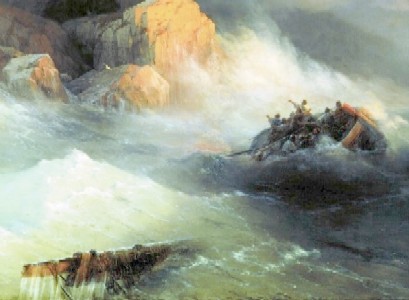
Artist: Ivan Konstantinovich Aivazovsky
An Overturned Ship, From the Painting Shipwreck (1876)
water, just enough for the masts to strike into the mud and keep the hull above water, so that the men could hold on until picked up by boats. Nevertheless two men were drowned." (George Francis Dow and John Henry Edmonds, The Pirates of the New England Coast 1630-1730, p. 200)
The threat of drowning has been an ever-present danger to men on ships since they decided to journey out onto the sea. In his 1764 book, Doctor John Wilkinson found that 115 vessels of Great Britain had been lost at sea since January 1st, 1758. "Allowing each vessel its proper compliment of hands, and the number of passengers, some of them certainly had on board, I found them [the number drowned to be] 2360."1 While we cannot be certain of Wilkinson's numbers, it suggests that reviving those nearly drowned would be a skill necessary for a surgeon during the golden age of piracy.
With that in mind, we will begin by looking at the situations that led to people on ships being drowned or nearly so. Next we'll look at sailors ability to swim. and what was done to retrieve a man fallen overboard. The remainder of the material will focus on the methods in use to resuscitate those nearly drowned during the golden age of piracy, with a look at why and how various methods were employed.
;1 John Wilkinson, Tutamen Nauticum or The Seaman's Prevention from Shipwreck, Diseases and Other Calamities Incident to Mariners, Part 1, p. 4
Causes of Drowning During the Golden Age of Piracy
"If the ship dashes against a rock, runs upon a shoal, is stranded by a storm, starts a plank, founders, or takes fire at sea, too often every soul perishes. Every tempest threatens destruction to many people on board ships; every lee shore is dangerous; fire is still more alarming. Pliny says of seamen, they are but three inches from eternity." (John Wilkinson,Tutamen Nauticum or The Seaman's Prevention from Shipwreck, Diseases and Other Calamities Incident to Mariners, Part 1, p. 2)
There were multiple ways for a sailor to drown. Period accounts and journals give multiple examples of the ways men could wind up in the water gasping for air including: sinking ships, fire aboard, drunkenness and individual accidents.
Sinking Ships
Perhaps the most obvious and disastrous reason men were drowned was because their ship sank. There could be multiple reasons for a ship to sink; it could run aground, be overturned in stormy weather or destroyed in battle. Storms caused some of the most extensive loss of life by drowning. A particularly violent storm could sink dozens or even hundreds of vessels.
The Great Storm of 1703 was one of the most severe storms recorded in southern Great Britain. John Keevil explains that the storm
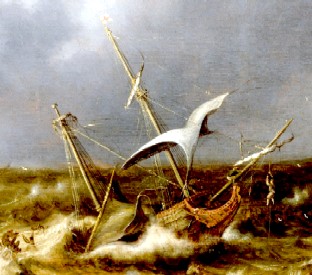
Artist: Willem Van Diest
Shipwreck in a Storm (1629)
caused the loss of sixteen naval vessels, including the Suffolk, hospital ship, an old sixth rate of ten guns lying off Bristol. All her eighty men were saved, but among the ships anchored in the Downs the number of men drowned was very great. There and off the Gunfleet lay [Sir Cloudesley] Shovell's and Leake's ships, newly returned from the Mediterranean, and, according to Leake, he saw 'between two to three thousand perish in this manner, without a possibility of helping them'; among the officers was Rear-Admiral Basil Beaumont in the Mary, whose whole ship's company of two hundred and sixty-nine men was lost. A later estimate places the total number drowned at fifteen hundred officers and men."1
Most storms weren't quite that extensive in their impact. Still, the Caribbean, site of so much pirate activity during the golden age of piracy, is famous for its hurricanes. While making for the Leeward Island in the Caribbean, Edward Low's crew "met with such a Hurricane of Wind, that the like had not been known, the Sea ran Mountains high, and seemed to threaten them every Moment with Destruction, it was no Time now to look out for Plunder, but to save themselves, if possible, from perishing."2
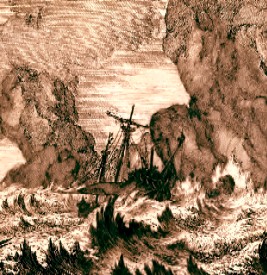
Artist: Arnoldus Montanus
Brasil de Nieuwe en Onbekende Weereld (1671)
Ships could also be sunk when their hull was perforated. Sometimes this was caused when storms drove the ship into rocks and reefs. Pirate captain Thomas Tew was on shore in Madagascar when "a violent storm came up suddenly with so high a sea that Captain Tew could not go out in his ship. The storm increased and in less than two hours the 'Victore' parted her cables and was driven ashore on a steep point where everyone on board was drowned in sight of Tew who could give no assistance."3
Pirate Charles Vane was cruising when "a violent Turnado overtook him, which separated him from his Consort, and after two Days Distress, threw his Sloop upon a small uninhabited Island, near the Bay of Honduras, where she was staved to Pieces, and most of her Men drowned"4.
At other times, weather had nothing to do with a shipwreck. Sailor Edward Barlow reported that in 1666 the Pembroke, a small frigate, was anchored in the Portland Road with a fleet of merchant ships and some men-of-war when "a frigate called the Fairfax ran on board of her; and her anchor taking hold of the small frigate under water, tore a whole plank out, and she sank immediately, and many of her men there 'drownded'."5
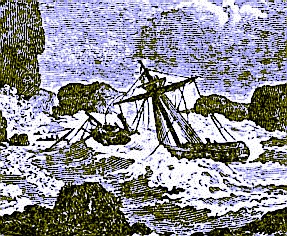
Wreck of the Halsewell On the Coast of England
From Thrilling Narratives of Mutiny, Murder and Piracy
Boats could also flip over due to poor loading and planning. Barlow's journal also relates the story of a 400 ton ship off Jamaica, "being a little top-heavy, would not bear herself very well; and all the men running over on one side to do some work, she was fallen over and overset and sunk down to Rights, and about ten or a dozen men 'drownded', and all the sugar [she was loaded with was] lost... had it been in many places, the ship and all had been lost, but the harbour being a fine smooth clear harbour, they, with much trouble, did save the ship."6
Jeremy Roch tells a similar tale of his ship's pinnace (smaller boat) in 1667. It was returning from town with a several passengers when it "rolled much by reason of a swelling sea that went, though there was little or no wind, they all too hasty to enter the ship which making a heel that way brought the boat’s side under water. Then all of them suddenly shifting to the other side, overset the boat, so that they were like all to be lost, for there was no boat near to take them up."7 Of the 23 passengers, 22 survived, "only the Chaplain having drank too much [sea] water, or else with fear, was found dead."8
Bartholomew Sharp provides yet another example of poor planning that resulted in disaster in 1681. He explained that "one of our Canoes, that was a little too deeply laden with Iron-work, [which caused it] to sink, whereby one of our Men, whose Name was John Alexander, was drowned."9
1 John J. Keevil, Medicine and the Navy 1200-1900: Volume II – 1640-1714, p. 213; 2 Captain Charles Johnson, A general history of the pirates, 3rd Edition, p. 171; 3 George Francis Dow and John Henry Edmonds, The Pirates of the New England Coast 1630-1730, p. 91; 4 Johnson, p. 147; 5 Edward Barlow, Barlow’s Journal of his Life at Sea in King’s Ships, East and West Indiamen & Other Merchantman From 1659 to 1703, p. 131; 6 Barlow, p. 331-2; 7,8 Bruce S. Ingram, Three Sea Journals of Stuart Times, 1936, p. 66; 9 Bartholomew Sharp, "Captain Sharp's Journal of His Expedition," from William Hacke's A collection of original voyages, p. 49
Fire
A ship on fire was a terror to everyone on board. When a ship caught fire, many a man had to consider the choice between being burned to death or potentially drowning at sea. This would be particularly true of pirates and privateers who stayed away from busy ports while roving and so could likely expect little outside assistance after having jumped into the sea.
For men who couldn't swim, fire presented a horrific choice. As Captain Nathaniel Uring explained when facing a shipboard blaze, "I must of Necessity have perished in the Flames, or been drowned, for I could not swim, neither could I come near the Place where the Lanyard was fastened to have hauled to the Boat [to escape in it],
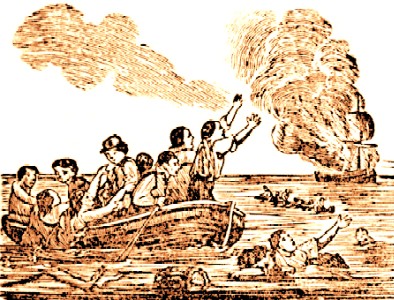
Burning of the Prince -
From Thrilling Narratives of Mutiny, Murder and Piracy
for the Violence of the Flame, which reached beyond it."1
Still, fear of fire on board a vessel often led to men taking to the sea and risking drowning rather than being burned to death. In 1691, Edward Barlow reported that a ship named the St. Michael caught fire "by neglect of some fire or candle carelessly left near the powder rooms, which presently caused the alarum, several men being struck with that fear of being blown up that they presently leaped overboard; and before any could come to take them up were, several of them, drowned in the sea"2.
Even men who could swim would be unlikely to survive if the ship were too far from land for them to swim to safety. Yet if the fire raged out of control, swimming presented the only viable option for survival. If the boats on the ship could get away from the ship, they provided greater chance for survival. The black powder in the gun-room of Edward Coxere's ship caught fire, creating a state of panic. "So dreadful was it that the men which could swim leapt over board into the sea to swim to the boats that were at the stern of our ship."3 This assumes there were enough boats for the crew. An overcrowded boat was likely to sink and put its occupants back in the water, swimming as we have already seen.
1 Nathaniel Uring, A history of the voyages and travels of Capt. Nathaniel Uring, p. 6-7; 2 Edward Barlow, Barlow’s Journal of his Life at Sea in King’s Ships, East and West Indiamen & Other Merchantman From 1659 to 1703, p. 416; 3 Edward Coxere, Adventures by Sea of Edward Coxere, p. 7-8
Drunkenness
There's nothing quite like a little too much alcohol to make people clumsy, foolhardy and/or inattentive. Although it was unlikely that drunkenness would have been allowed when a ship was underway - even on a pirate ship - when a ship was at anchor, the situation was different. Pirates and sailors were known to celebrate when they were stopped and this sometimes led to situations that resulted in drowning.
While in Goa in 1697, Edward Barlow reported that "we had the misfortune to have one of our seamen drowned, being in drink, for rack [wine] being cheap [there] everyone gets a little [of it]."1 Unfortunately Barlow doesn't report the exact circumstances. Captain Francis Rogers gives a more detailed account of a similar circumstance, revealing how one might drown during a drunken revelry. "In a frolic and in drink, Captain Kimber and I went

Edward Low's Men Drinking & Celebrating,
From
Histoire der Engelsche zee-roovers (1725)
overboard out of the boat, with all our cloths on. (I had liked to have been drowned, for (I) could not swim.)"2
Barlow provides us with another example of why alcohol and seamen are not a good combination. While under sail, "our cook, named William Cox, in the night rises out of his sleep and goes into the ship's head and either slips or falls overboard and was 'drownded': he was drunk, and was not missed till the next day at nine in the morning"3.
Perhaps one of the more celebrated examples of drunken drowning came from the Wager, one of circumnavigator George Anson's store ships which wrecked near the coast of what is now Chile in 1741.
Most of the men had disembarked with alacrity, but it had become evident to the dozen or so sailors who were still on board that the Wager would not soon break up. This knowledge made them 'very riotous,' and to celebrate, they had rifled every chest and box in easy reach, looking for spoils. Further, they had brought up to the hatchways casks of wine and brandy. When Byron came back on deck, they were proceeding to get drunk. Soon they would be so inebriated that several of them would actually drown in the 'tween decks, where the water flowed in, and the corpses would be left by the other celebrants to float there.4
Liquor and swimming clearly do not make for good companions.
1 Edward Barlow, Barlow’s Journal of his Life at Sea in King’s Ships, East and West Indiamen & Other Merchantman From 1659 to 1703, p. 493; 2 Bruce S. Ingram, Three Sea Journals of Stuart Times, 1936, p. 219; 3 Barlow, p. 445-6; 4 Edward E. Leslie, Desperate Journeys, Abandoned Souls, p. 138
Individual Accidents
Of course, sometimes it is just a simple accident that results in someone being drowned, or nearly so. The ship's bathroom seems to have been a particularly treacherous place. Like the unfortunate cook William Cox discussed in the previous section, sea surgeon James Yonge nearly went overboard while using the loo.
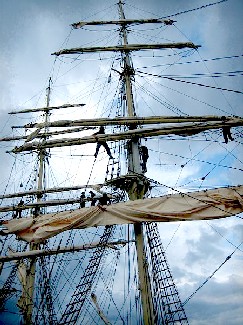
Photographer: Wiki user pollo
Men Working the Sails on the Brig Tre Kroner
I narrowly escaped drowning, for going into the main chains [the woven rigging attached to the side of the ship which holds the main mast up] to exonerate nature, the ship yared to port and heeled so deep to starboard, the side whereon I was, that I were dipped head and ears, the affright of which, together with the surface motion of the sea, had almost forced me from my hold. If it had, I could not have escaped.1
Being up the masts and working the sails also put one in a precarious position that could lead to a sailor falling into the ocean. Edward Barlow provides an example, noting that in 1696 the "Charles came to an accident, losing four of her seamen, for being upon the main topsail yard about to reef and shorten sail, the weather brace [rope] broke; and the yard [cross piece on the mast horizontal to the deck] flying away at once and the sail filling, struck four of the men off the yard; two falling into the sea, were drowned, and two falling into the ship, were killed by the fall."2
In fact, working anywhere outside of the deck could be disastrous. In 1676, chaplain Henry Teonge explains that seaman "Summersett Evins, going up the mizzen chains to clear the pendant, fell down and was drowned."3 Privateer George Shelvocke mentioned another danger to sailors that caused drowning in his book describing his 1719-22 voyage. When they were going around Cape Horn through the cold climes on October 1st, 1719, "they were furling the main-sail, one William Camell cry'd out, that his hands and fingers were so benumbd that he could not hold himself, but before those that were next to him could come to his assistance, he fell down and was drown'd."4 A ship was clearly a dangerous place to work and drowning was a ever-present threat.
1 James Yonge, The Journal of James Yonge [1647-1721] Plymouth Surgeon, p. 33; 2 Edward Barlow, Barlow’s Journal of his Life at Sea in King’s Ships, East and West Indiamen & Other Merchantman From 1659 to 1703, p. 465; 3 Henry Teonge, The Diary of Henry Teonge, Chaplain on Board H.M.’s Ships Assistance, Bristol, and Royal Oak, 1675-1679, p. 194; 4 George Shelvocke, A Voyage Round the World by Way of the Great South Sea, 1726, p. 71

